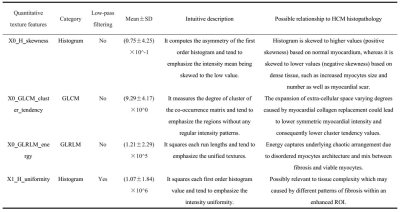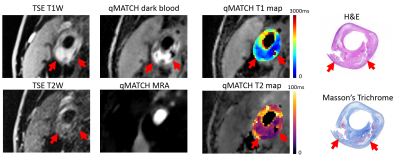|
Cardiovascular Imaging Biomarkers
Combined Educational & Scientific Session
ORGANIZERS: Reza Nezafat, Tim Leiner
Tuesday, 19 June 2018
| S02 |
16:15 - 18:15 |
Moderators: René Botnar, Zahi Fayad |
Skill Level: Intermediate to Advanced
Session Number: Tu-07
Overview
This course will review methods for imaging biomarkers including mulitmodality techniques of assessing atherosclerosis and compehensive rapid 3D and 4D imaging of the heart.
Target Audience
Attendees, both physicians and scientists, who have intermediate-to-advanced knowledge of cardiac MR methodology and wish to learn about evolving approaches to assessing atherosclerosis and cardiac disease and want to become familiar with emerging imaging technologies.
Educational Objectives
As a result of attending this course, participants should be able to:
-Describe novel imaging biomarkers for cardiovascular disease;
-Summarize rapid acquisition strategies for comprehensive 3D and 4D assessment of the heart; and
-Discuss multi-modality approaches to assessing atherosclerosis.
16:15
|
|
 MRI of Atherosclerosis of Various Vascular Beds in the Era of Artificial Intelligence MRI of Atherosclerosis of Various Vascular Beds in the Era of Artificial Intelligence
Chun Yuan
|
16:45
|
|
 Towards 3D & 4D Comprehensive CMR Towards 3D & 4D Comprehensive CMR
Matthias Stuber
Imaging of the heart remains time consuming, operator dependent, and inefficient. New paradigms that combine modern image acquisition and reconstruction strategies promise significantly improved ease-of-use and time efficiency. These are critical ingredient for a more wide-spread adoption and improved clinical impact of cardiac MR in general.
|
17:15
|
0563.
 |
LGE-CMR derived texture features reflect poor prognosis in hypertrophic cardiomyopathy patients with systolic dysfunction: preliminary results
Video Permission Withheld
Sainan Cheng, Mengjie Fang, Di Dong, Jie Tian, Shihua Zhao
In this study, we evaluated the prognostic value of texture features based on late gadolinium enhancement cardiac magnetic resonance (LGE-CMR) images in hypertrophic cardiomyopathy (HCM) patients with systolic dysfunction. 1.5 T CMR cine and LGE images were performed on 67 HCM patients with systolic dysfunction. Texture features were extracted from LGE images. Cox proportional hazard analysis and Kaplan-Meier analysis were used to determine the association of texture features with event free survival. The result showed that increased LGE heterogeneity (higher X0_GLRLM_energy, higher X1_H_uniformity, lower X0_H_skewness and lower X0_GLCM_cluster_tendency) was associated with adverse events in HCM patients with systolic dysfunction.
|
17:27
 |
0564.
 |
 Cardiac MRI measured left atrial function can identify patient with pulmonary hypertension due to left heart disease. Cardiac MRI measured left atrial function can identify patient with pulmonary hypertension due to left heart disease.
Christopher Johns, James Wild, Pankaj Garg, Calum Sowden, Ibrahim Mahmoud, Smitha Rajaram, Charlie Elliot, Robin Condliffe, Athanasios Charalampopoulos, David Kiely, Andrew Swift
Patients with left heart disease commonly develop pulmonary hypertension (PH) [1], initially due to passive backward transmission of high left ventricular filling pressures through the pulmonary circulation. Assessment of left atrial reservoir and pump function using changes in left atrial area over time are useful to differentiate patients with left heart disease from other cases of suspected pulmonary hypertension (Mann-Whitney u test p-value 0.0015 and 0.0067 respectively).
|
17:39
|
0565.
 |
 All-In-One MRI of Atherosclerosis: Towards Higher Clinical Value All-In-One MRI of Atherosclerosis: Towards Higher Clinical Value
Yibin Xie, Anthony Christodoulou, Nan Wang, Zixin Deng, Bill Zhou, Wei Yu, Debiao Li
Multi-contrast MRI is a promising yet under-utilized imaging modality for evaluating the disease status of atherosclerosis. Major drawbacks of conventional protocols include long complex scan procedures and variability in image interpretation due to the qualitative nature of the images. In this work we propose a highly efficient MRI technique, qMATCH, which allows for all-in-one quantitative evaluation of carotid atherosclerosis. Preliminary results in phantom, normal subjects, and patients with known carotid atherosclerosis are reported.
|
17:51
 |
0566.
 |
 MR Imaging Biomarkers of Cardiac Function and Rotational Mechanics in Boys with Duchenne Muscular Dystrophy MR Imaging Biomarkers of Cardiac Function and Rotational Mechanics in Boys with Duchenne Muscular Dystrophy
Patrick Magrath, Pierangelo Renella, Nancy Halnon, Subha Raman, Daniel Ennis
Duchenne Muscular Dystrophy (DMD) severely impacts heart health. Decreasing LV ejection fraction (EF) is a late and highly variable outcome in this cohort. Earlier indications of cardiac involvement would improve patient management and provide insight into the utility of emerging therapy. Boys with DMD (N=25) and healthy volunteers (N=8) underwent cardiac MRI exams including short-axis tagged images. EF, peak LV twist, and peak mid-wall circumferential strain (Ecc) were estimated. Ecc and twist were significantly reduced in patients (9.3°±4.3° vs. 14.8°±3.6°, p< 0.004) and (-15.8±5.8% vs. -18.5±3.2%, p<0.02). Whereas, EF was not significantly different between groups. ~50% of DMD patients with normal EF had reduced twist and Ecc. Reduced peak LV twist and mid-wall Ecc measured by MR tagging may be earlier and more sensitive indicators of cardiac involvement in boys with DMD.
|
18:03
|
0567.
 |
 Assessment Pre- and Post-Ablation Energetics and Vortex Size Alterations of Left Atrial Hemodynamics in Patients with Paroxysmal Atrial Fibrillation: 4D flow MRI Study Assessment Pre- and Post-Ablation Energetics and Vortex Size Alterations of Left Atrial Hemodynamics in Patients with Paroxysmal Atrial Fibrillation: 4D flow MRI Study
Julio Garcia, Mohammed Elbaz, Carmen Lydell, Andrew Howarth, Frank Prato, Maria Drangova, Rebecca Thornhill, Pablo Nery, Stephen Wilton, Allan Skanes, Faramarz Samavati, James White
This study may be of interest for clinicians and researchers who study left atrial diseases and arrhythmias. This study demonstrated a significant decrease of flow energetics and vortex size in patients with history of atrial fibrillation.
|
18:15
|
|
Adjournment & Meet the Teachers |
|







